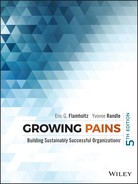Part II
Mastering the Tools for Building Sustainably Successful Organizations®
Part One of this book presented the key factors that determine organizational success and provided a framework for understanding the stages of organizational growth. Part Two focuses on a set of tools that can be used by company leaders to promote successful growth and development. Specifically, we will discuss some of the major elements of an organization's management infrastructure—its management systems and corporate culture. Management systems and corporate culture were described briefly in Chapter 2, and their places on the Pyramid of Organizational Development were shown in Figure II.1.

Figure II.1 The Management System
An organization's management systems consist of (1) the planning system (including the strategic planning process), (2) the organization structure, (3) its system for management and leadership development, and (4) the company's control or performance management systems. Management systems have a critical influence on an organization's current and future performance and profitability.
A planning system includes the processes for strategic planning, operational planning, budgeting, and contingency planning. The strategic planning process is a critical resource or tool for managing organizational growth and development. Chapter 6 presents concepts and methods of strategic planning. It also explains the role of strategic planning in promoting long-term success and provides a case study example of how to develop and use this tool in practice. Finally, it examines an organization's requirements for strategic planning at different stages of growth.
The way people are organized in a business enterprise can have a critical impact on overall operating effectiveness, efficiency, and, in turn, bottom-line profitability. Chapter 7 discusses the nature of an organization's structure and examines the alternative forms of structure. It also identifies criteria for the design and evaluation of organizational structure as well as presents case studies of structural issues at different stages of growth.
Control or performance management systems are another critical component of the organization's management systems. Chapter 8 discusses the need for control and the nature and role of organizational control and performance management systems. It also presents a model of the key components of a performance management system and explains how they function to motivate and control behavior. Finally, it examines the design of performance management systems at different stages of growth.
Ensuring that those in leadership roles have the skills needed to manage organizational transitions is critical to long-term success. Management and leadership development can be used not only to help managers and leaders develop the skills they need, but it can also help to shape or reshape the corporate culture. Chapter 9 examines the tools and functions of management development and presents case studies that illustrate how companies can use the leadership development process to enhance organizational performance and support long-term success. It also describes the design and focus of leadership development programs at different stages of growth.
The nature and management of a company's culture also has a significant impact on organizational success. Culture influences an organization's ability to develop the systems needed to support its growth. Like other variables in the Pyramid of Organizational Development, culture must be effectively managed to promote long-term organizational success. Chapter 10 describes the nature of corporate culture and how it is manifested in organizations. It also presents techniques for managing this variable effectively and describes the nature of corporate culture at different stages of organizational growth. Finally, it presents a case study of the steps organizations should take to better understand and manage their cultures.
Part Two, then, gives a basic description of some of the most important concepts and tools that can help leaders successfully manage organizational transitions and build a successful enterprise over the long term. Figure II.1 summarizes schematically the relations among the key components of an organization's management system. As seen in the figure, the management process begins with the planning system, which articulates an organization's business concept, strategic mission, objectives, and goals. The company's plan drives (should determine) how it is organized (organizational structure). This, in turn, enhances the organization's operational systems and leads to results, which are measured by the performance measurement system.
The performance measurement system is a component of the company's performance management system, which also includes objectives and goals from the planning system as well as performance appraisals and rewards (compensation). Performance review meetings, as well as information, are the mechanisms through which these components of the overall management system operate. The management and leadership development system supports the other components of the management system by training leaders in the skills required to do planning, to use the various forms of organizational structure, and to manage day-to-day operations. Input about the skills that need to be built through management development is received from the performance appraisal process.
Leadership—a key component of the management system—is not shown explicitly in Figure II.1, but it should be viewed as a part of the various components such as strategic planning (strategic leadership), operations, performance review meetings, and performance appraisal (operational leadership). (We will discuss leadership in more depth in Chapter 12.) Similarly, corporate culture is not explicitly shown in Figure II.1, but it must be recognized that corporate culture affects and is affected by all of the components of the management system.
